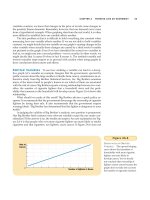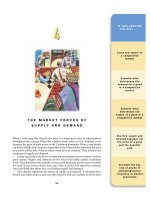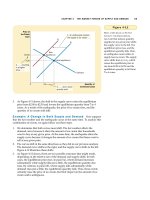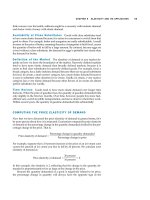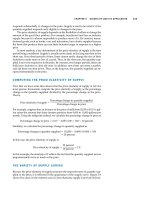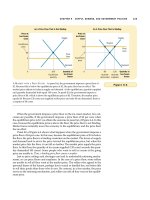Tài liệu Ten Principles of Economics - Part 60 doc
Bạn đang xem bản rút gọn của tài liệu. Xem và tải ngay bản đầy đủ của tài liệu tại đây (200.97 KB, 10 trang )
CHAPTER 27 THE MONETARY SYSTEM 611
Another example of commodity money is cigarettes. In prisoner-of-war camps
during World War II, prisoners traded goods and services with one another using
cigarettes as the store of value, unit of account, and medium of exchange. Simi-
larly, as the Soviet Union was breaking up in the late 1980s, cigarettes started re-
placing the ruble as the preferred currency in Moscow. In both cases, even
nonsmokers were happy to accept cigarettes in an exchange, knowing that they
could use the cigarettes to buy other goods and services.
Money without intrinsic value is called fiat money. A fiat is simply an order or
decree, and fiat money is established as money by government decree. For exam-
ple, compare the paper dollars in your wallet (printed by the U.S. government)
and the paper dollars from a game of Monopoly (printed by the Parker Brothers
game company). Why can you use the first to pay your bill at a restaurant but not
the second? The answer is that the U.S. government has decreed its dollars to be
valid money. Each paper dollar in your wallet reads: “This note is legal tender for
all debts, public and private.”
Although the government is central to establishing and regulating a system of
fiat money (by prosecuting counterfeiters, for example), other factors are also re-
quired for the success of such a monetary system. To a large extent, the acceptance
of fiat money depends as much on expectations and social convention as on gov-
ernment decree. The Soviet government in the 1980s never abandoned the ruble as
the official currency. Yet the people of Moscow preferred to accept cigarettes (or
even American dollars) in exchange for goods and services, because they were
more confident that these alternative monies would be accepted by others in the
future.
MONEY IN THE U.S. ECONOMY
As we will see, the quantity of money circulating in the economy, called the money
stock, has a powerful influence on many economic variables. But before we con-
sider why that is true, we need to ask a preliminary question: What is the quantity
of money? In particular, suppose you were given the task of measuring how much
money there is in the U.S. economy. What would you include in your measure?
The most obvious asset to include is currency—the paper bills and coins in the
hands of the public. Currency is clearly the most widely accepted medium of ex-
change in our economy. There is no doubt that it is part of the money stock.
Yet currency is not the only asset that you can use to buy goods and services.
Many stores also accept personal checks. Wealth held in your checking account is
almost as convenient for buying things as wealth held in your wallet. To mea-
sure the money stock, therefore, you might want to include demand deposits—
balances in bank accounts that depositors can access on demand simply by writing
a check.
Once you start to consider balances in checking accounts as part of the money
stock, you are led to consider the large variety of other accounts that people hold
at banks and other financial institutions. Bank depositors usually cannot write
checks against the balances in their savings accounts, but they can easily transfer
funds from savings into checking accounts. In addition, depositors in money mar-
ket mutual funds can often write checks against their balances. Thus, these other
accounts should plausibly be part of the U.S. money stock.
fiat money
money without intrinsic value
that is used as money because
of government decree
currency
the paper bills and coins in the
hands of the public
demand deposits
balances in bank accounts that
depositors can access on demand
by writing a check
“Gee, these new twenties look
just like Monopoly money.”
612 PART TEN MONEY AND PRICES IN THE LONG RUN
CASE STUDY
WHERE IS ALL THE CURRENCY?
One puzzle about the money stock of the U.S. economy concerns the amount of
currency. In 1998 there was about $460 billion of currency outstanding. To put
this number in perspective, we can divide it by 205 million, the number of
adults (age sixteen and over) in the United States. This calculation implies that
the average adult holds about $2,240 of currency. Most people are surprised to
learn that our economy has so much currency because they carry far less than
this in their wallets.
Who is holding all this currency? No one knows for sure, but there are two
plausible explanations.
The first explanation is that much of the currency is being held abroad. In
foreign countries without a stable monetary system, people often prefer U.S.
dollars to domestic assets. It is, in fact, not unusual to see U.S. dollars being
used overseas as the medium of exchange, unit of account, and store of value.
The second explanation is that much of the currency is being held by drug
dealers, tax evaders, and other criminals. For most people in the U.S. economy,
In a complex economy such as ours, it is not easy to draw a line between assets
that can be called “money” and assets that cannot. The coins in your pocket are
clearly part of the money stock, and the Empire State Building clearly is not, but
there are many assets in between these extremes for which the choice is less clear.
Therefore, various measures of the money stock are available for the U.S. economy.
Table 27-1 shows the two most important, designated M1 and M2. Each of these
measures uses a slightly different criterion for distinguishing monetary and non-
monetary assets.
For our purposes in this book, we need not dwell on the differences between
the various measures of money. The important point is that the money stock for the
U.S. economy includes not just currency but also deposits in banks and other finan-
cial institutions that can be readily accessed and used to buy goods and services.
Table 27-1
T
WO
M
EASURES OF THE
M
ONEY
S
TOCK FOR THE
U.S. E
CONOMY
.
The two most widely followed
measures of the money stock
are M1 and M2.
M
EASURE
A
MOUNT IN
1998 W
HAT
’
S
I
NCLUDED
M1 $1,092 billion Currency
Traveler’s checks
Demand deposits
Other checkable deposits
M2 $4,412 billion Everything in M1
Savings deposits
Small time deposits
Money market mutual funds
A few minor categories
S
OURCE
: Federal Reserve.
CHAPTER 27 THE MONETARY SYSTEM 613
currency is not a particularly good way to hold wealth. Not only can currency
be lost or stolen, but it also does not earn interest, whereas a bank deposit does.
Thus, most people hold only small amounts of currency. By contrast, criminals
may avoid putting their wealth in banks, because a bank deposit gives police a
paper trail with which to trace their illegal activities. For criminals, currency
may be the best store of value available.
QUICK QUIZ: List and describe the three functions of money.
THE FEDERAL RESERVE SYSTEM
Whenever an economy relies on a system of fiat money, as the U.S. economy does,
some agency must be responsible for regulating the system. In the United States,
that agency is the Federal Reserve, often simply called the Fed. If you look at the
top of a dollar bill, you will see that it is called a “Federal Reserve Note.” The Fed
is an example of a central bank—an institution designed to oversee the banking
system and regulate the quantity of money in the economy. Other major central
It might seem natural to in-
clude credit cards as part of
the economy’s stock of money.
After all, people use credit
cards to make many of
their purchases. Aren’t credit
cards, therefore, a medium of
exchange?
Although at first this argu-
ment may seem persuasive,
credit cards are excluded from
all measures of the quantity of
money. The reason is that
credit cards are not really a
method of payment but a method of deferring payment.
When you buy a meal with a credit card, the bank that is-
sued the card pays the restaurant what it is due. At a later
date, you will have to repay the bank (perhaps with interest).
When the time comes to pay your credit card bill, you will
probably do so by writing a check against your checking ac-
count. The balance in this checking account is part of the
economy’s stock of money.
Notice that credit cards are very different from debit
cards, which automatically withdraw funds from a bank
account to pay for
items bought. Rather
than allowing the user
to postpone payment
for a purchase, a
debit card allows the
user immediate ac-
cess to deposits in a
bank account. In this
sense, a debit card is
more similar to a
check than to a credit
card. The account balances that lie behind debit cards are
included in measures of the quantity of money.
Even though credit cards are not considered a form of
money, they are nonetheless impor tant for analyzing the
monetary system. People who have credit cards can pay
many of their bills all at once at the end of the month, rather
than sporadically as they make purchases. As a result, peo-
ple who have credit cards probably hold less money on
average than people who do not have credit cards. Thus, the
introduction and increased popularity of credit cards may
reduce the amount of money that people choose to hold.
I
S THIS MONEY
?
Federal Reserve (Fed)
the central bank of the United States
FYI
Credit Cards,
Debit Cards,
and Money
central bank
an institution designed to oversee
the banking system and regulate the
quantity of money in the economy
614 PART TEN MONEY AND PRICES IN THE LONG RUN
banks around the world include the Bank of England, the Bank of Japan, and the
European Central Bank.
THE FED’S ORGANIZATION
The Federal Reserve was created in 1914, after a series of bank failures in 1907 con-
vinced Congress that the United States needed a central bank to ensure the health
of the nation’s banking system. Today, the Fed is run by its Board of Governors,
which has seven members appointed by the president of the United States and
confirmed by the Senate. The governors have 14-year terms. Just as federal judges
are given lifetime appointments to insulate them from politics, Fed governors are
given long terms to give them independence from short-term political pressures
when they formulate monetary policy.
Among the seven members of the Board of Governors, the most important is
the chairman. The chairman directs the Fed staff, presides over board meetings,
and testifies regularly about Fed policy in front of congressional committees. The
president appoints the chairman to a four-year term. As this book was going to
press, the chairman of the Fed was Alan Greenspan, who was originally appointed
in 1987 by President Reagan and later reappointed by Presidents Bush and
Clinton.
The Federal Reserve System is made up of the Federal Reserve Board in Wash-
ington, D.C., and 12 regional Federal Reserve Banks located in major cities around
the country. The presidents of the regional banks are chosen by each bank’s board
of directors, whose members are typically drawn from the region’s banking and
business community.
The Fed has two related jobs. The first job is to regulate banks and ensure the
health of the banking system. This task is largely the responsibility of the regional
Federal Reserve Banks. In particular, the Fed monitors each bank’s financial con-
dition and facilitates bank transactions by clearing checks. It also acts as a bank’s
bank. That is, the Fed makes loans to banks when banks themselves want to bor-
row. When financially troubled banks find themselves short of cash, the Fed acts
as a lender of last resort—a lender to those who cannot borrow anywhere else—in
order to maintain stability in the overall banking system.
The Fed’s second and more important job is to control the quantity of money
that is made available in the economy, called the money supply. Decisions by
policymakers concerning the money supply constitute monetary policy. At the
Federal Reserve, monetary policy is made by the Federal Open Market Committee
(FOMC). The FOMC meets about every six weeks in Washington, D.C., to discuss
the condition of the economy and consider changes in monetary policy.
THE FEDERAL OPEN MARKET COMMITTEE
The Federal Open Market Committee is made up of the seven members of the
Board of Governors and five of the 12 regional bank presidents. All 12 regional
presidents attend each FOMC meeting, but only five get to vote. The five with vot-
ing rights rotate among the 12 regional presidents over time. The president of the
New York Fed always gets a vote, however, because New York is the traditional
money supply
the quantity of money available
in the economy
monetary policy
the setting of the money supply by
policymakers in the central bank
CHAPTER 27 THE MONETARY SYSTEM 615
financial center of the U.S. economy and because all Fed purchases and sales of
government bonds are conducted at the New York Fed’s trading desk.
Through the decisions of the FOMC, the Fed has the power to increase or de-
crease the number of dollars in the economy. In simple metaphorical terms, you
can imagine the Fed printing up dollar bills and dropping them around the coun-
try by helicopter. Similarly, you can imagine the Fed using a giant vacuum cleaner
to suck dollar bills out of people’s wallets. Although in practice the Fed’s methods
for changing the money supply are more complex and subtle than this, the
helicopter-vacuum metaphor is a good first approximation to the meaning of
monetary policy.
We discuss later in this chapter how the Fed actually changes the money sup-
ply, but it is worth noting here that the Fed’s primary tool is open-market opera-
tions—the purchase and sale of U.S. government bonds. (Recall that a U.S.
government bond is a certificate of indebtedness of the federal government.) If the
FOMC decides to increase the money supply, the Fed creates dollars and uses
them to buy government bonds from the public in the nation’s bond markets.
After the purchase, these dollars are in the hands of the public. Thus, an open-
market purchase of bonds by the Fed increases the money supply. Conversely, if
the FOMC decides to decrease the money supply, the Fed sells government bonds
from its portfolio to the public in the nation’s bond markets. After the sale, the dol-
lars it receives for the bonds are out of the hands of the public. Thus, an open-
market sale of bonds by the Fed decreases the money supply.
The Fed is an important institution because changes in the money supply can
profoundly affect the economy. One of the Ten Principles of Economics in Chapter 1
is that prices rise when the government prints too much money. Another of the
Ten Principles of Economics is that society faces a short-run tradeoff between infla-
tion and unemployment. The power of the FOMC rests on these principles. For
reasons we discuss more fully in the coming chapters, the FOMC’s policy deci-
sions have an important influence on the economy’s rate of inflation in the long
run and the economy’s employment and production in the short run. Indeed, the
chairman of the Federal Reserve has been called the second most powerful person
in the United States.
QUICK QUIZ: What are the primary responsibilities of the Federal
Reserve? If the Fed wants to increase the supply of money, how does it
usually do it?
BANKS AND THE MONEY SUPPLY
So far we have introduced the concept of “money” and discussed how the Federal
Reserve controls the supply of money by buying and selling government bonds in
open-market operations. Although this explanation of the money supply is correct,
it is not complete. In particular, it omits the central role that banks play in the mon-
etary system.
